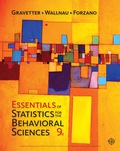
Concept explainers
Briefly define each of the following:
- a. Distribution of sample means
- b. Central limit theorem
- c.
Expected value of M - d. Standard error of M
a.
To Define: The distribution of sample means.
Answer to Problem 1P
Distribution of sample means consists of means of all possible samples of fixed size that can be selected from a given population.
Explanation of Solution
Since, it is quite difficult to study the complete population, so sample of fixed size are selected which are representative of population. If all the possible samples of fixed size are listed, they follow certain distributions. Similarly, distribution of sample means consists of sample means of all the possible samples of fixed size that can be selected from a given population.
Conclusion:
Distribution of sample means consists of sample means of all the possible samples of fixed size that can be selected from a given population.
b.
To Define: Central limit theorem.
Answer to Problem 1P
According to central limit theorem, for any population with mean
Explanation of Solution
Since, sample means are the representatives of the population means, so as sample size increases, most of the samples piled up closer to the population mean. Therefore, as sample size increases sample means tends to population mean and standard error of sample means decreases. So, this intuition is stated in central limit theorem as:
For any population with mean
Conclusion:
According to central limit theorem, for any population with mean
c.
To Define: Expected value of M.
Answer to Problem 1P
The expected value of M is the average of means for all the possible samples of the fixed size which can be selected from given population.
Explanation of Solution
The sample means are the representative of the population mean from which samples have been drawn. The average of means for all possible samples of fixed size takes all population units into the consideration and equals to population mean. Therefore, the expected value of M is the average of means for all the possible samples of the fixed size which can be selected from given population and is equals to the population mean.
Conclusion:
The expected value of M is the average of means for all the possible samples of the fixed size which can be selected from given population.
d.
To Define: Standard error of M.
Answer to Problem 1P
Standard error of M measures the average distance of M from the population mean and is equals to
Explanation of Solution
Since, distribution of sample means consists of means for all the possible samples of fixed size n from the given population. So, standard error of M measures the average distance of M from the population mean. In other words, standard error of M is the standard deviation of the distribution of the sample means and is equals to
Conclusion:
Standard error of M is the standard deviation of the distribution of the sample means and is equals to
Want to see more full solutions like this?
Chapter 7 Solutions
Essentials of Statistics for The Behavioral Sciences (MindTap Course List)
 MATLAB: An Introduction with ApplicationsStatisticsISBN:9781119256830Author:Amos GilatPublisher:John Wiley & Sons Inc
MATLAB: An Introduction with ApplicationsStatisticsISBN:9781119256830Author:Amos GilatPublisher:John Wiley & Sons Inc Probability and Statistics for Engineering and th...StatisticsISBN:9781305251809Author:Jay L. DevorePublisher:Cengage Learning
Probability and Statistics for Engineering and th...StatisticsISBN:9781305251809Author:Jay L. DevorePublisher:Cengage Learning Statistics for The Behavioral Sciences (MindTap C...StatisticsISBN:9781305504912Author:Frederick J Gravetter, Larry B. WallnauPublisher:Cengage Learning
Statistics for The Behavioral Sciences (MindTap C...StatisticsISBN:9781305504912Author:Frederick J Gravetter, Larry B. WallnauPublisher:Cengage Learning Elementary Statistics: Picturing the World (7th E...StatisticsISBN:9780134683416Author:Ron Larson, Betsy FarberPublisher:PEARSON
Elementary Statistics: Picturing the World (7th E...StatisticsISBN:9780134683416Author:Ron Larson, Betsy FarberPublisher:PEARSON The Basic Practice of StatisticsStatisticsISBN:9781319042578Author:David S. Moore, William I. Notz, Michael A. FlignerPublisher:W. H. Freeman
The Basic Practice of StatisticsStatisticsISBN:9781319042578Author:David S. Moore, William I. Notz, Michael A. FlignerPublisher:W. H. Freeman Introduction to the Practice of StatisticsStatisticsISBN:9781319013387Author:David S. Moore, George P. McCabe, Bruce A. CraigPublisher:W. H. Freeman
Introduction to the Practice of StatisticsStatisticsISBN:9781319013387Author:David S. Moore, George P. McCabe, Bruce A. CraigPublisher:W. H. Freeman





